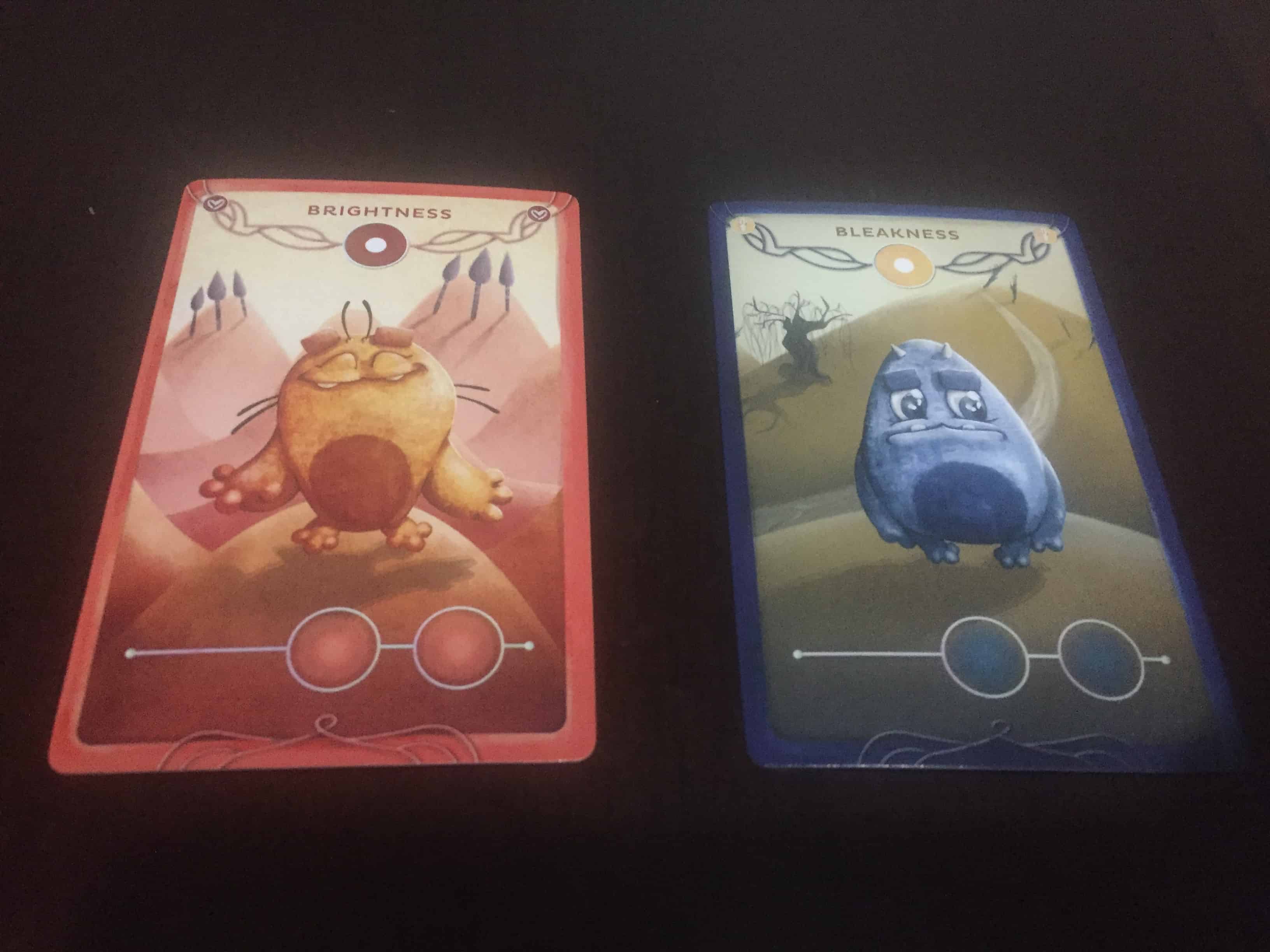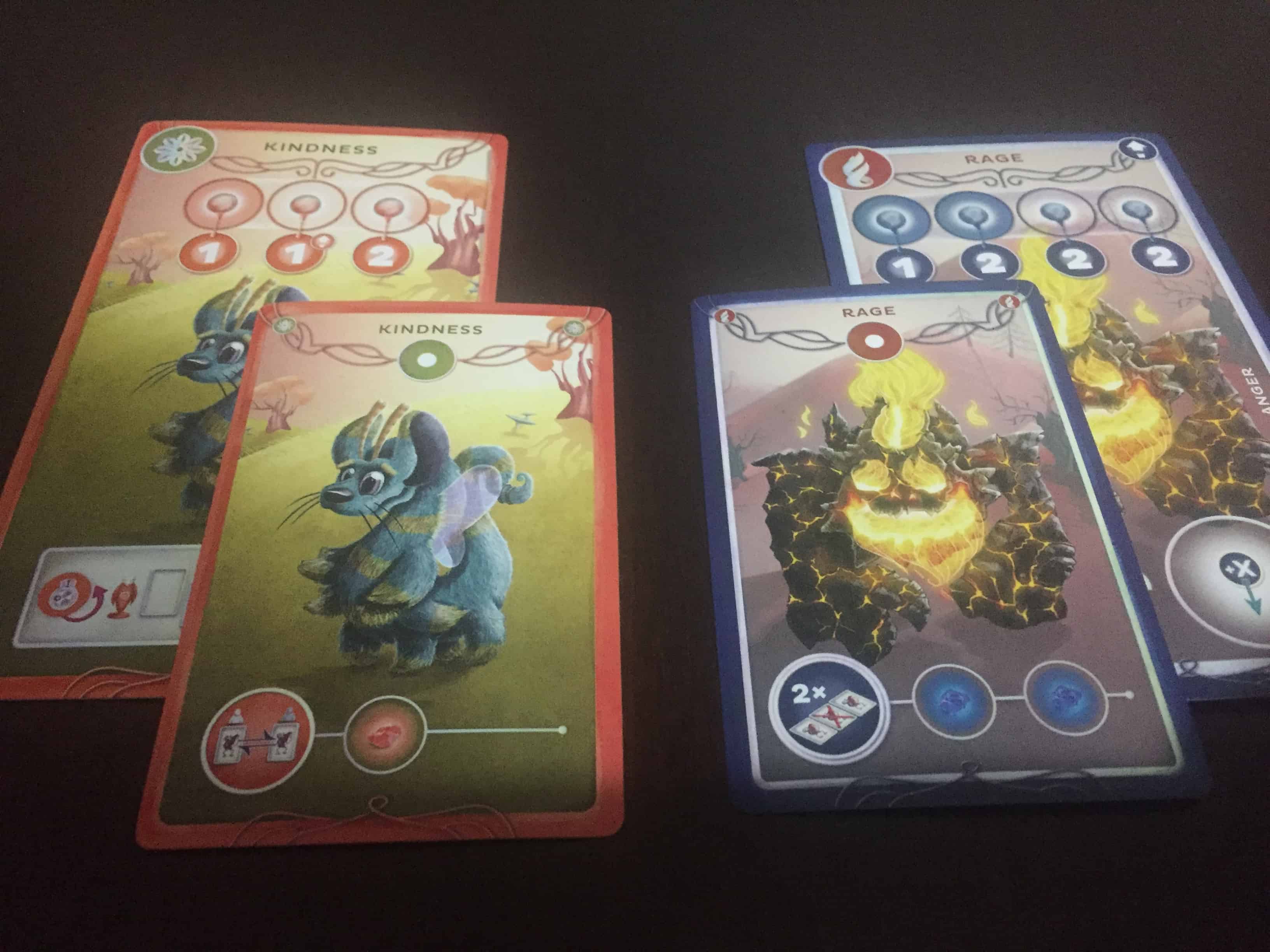Cerebria: The Card Game is a competitive, tactical, and highly interactive game for 2-5 players, designed by Frigyes Shoberi with Istvan Posci, Richard Amann and Viktor Peter, published by Mindclash Games.
—
I recently taught the behemoth of a board game known as Cerebria: The Inside World at a local library event. Almost everyone at the meetup, at one point or another, slowed down to behold the full Cerebria game laid out on the table. The huge board and dazzling color scheme drew them in, while many folks also thumbed through the decks of cards to check out Inside World’s quirky cast of characters. However, Cerebria: The Inside World presents a high complexity barrier for many gamers. I would start to explain it, but then folks would get intimidated and move along.
Enter Cerebria: The Card Game, a more accessible product with the same eye-catching art assets from Villo Farkas, Jamie Sichel, and Pedro Alberto. Where Cerebria: The Inside World held hundreds of cards, a huge nine-panel board, minis, tokens, and a partridge in a pear tree, the Card Game only has a few tokens and a 96 card deck. The card game retains many of the core ideas of it’s namesake, but does it pack a similar punch?
How to Play Cerebria: The Card Game
The Goal
In the Card Game, you strive to earn what the game calls the “strongest personality”. This means that, unlike the main game, you do not represent either Gloom or Bliss in your quest for victory. Rather, you opportunistically play from what the central tableau gives you and score based on whether you have used Gloom or Bliss cards. You can win the game by earning 12 Gloom victory points, 12 Bliss victory points, or 7 of each to achieve balance.

The Cards
On your turn, you will generally do one of two things – draft a card from a central market, or play a card with corresponding charges into your personal tableau. Or, as the rulebook puts it, play “emotions” with “identity fragments” into your “mindset”.
[Aside: Could the rulebook have used more non-specific gamer terms, rather than in-world jargon? Probably! Both Cerebria products trade in a lot of in-world jargon that might be immersive for some, but others might find confusing. I will use general gamer terms in this description for clarity.]
Once you have built up some cards, you can use their powers on future turns as discreet actions, in addition to your two main actions. The card actions are… pretty mean! You can steal a card from an opponent’s hand, make him or her discard a tableau card, or swap your spent, magic-less card for something with a lot of powers (which is also VP) in another player’s tableau.
Two key restrictions mitigate all of that meanness 1) you have to have charges to spend on your attack cards, which are not easy to refill, and 2) the opponent can block your intrusions by discarding a card with the same color as the attacking card.
Scoring and Winning
If a player empties a central market column on their turn, everyone immediately enters a scoring round. You score each unused charge on your cards, as well as spent charges that you managed to catch on special support cards called Bleakness and Brightness. In addition, if you manged to complete some kind of color set in your tableau (four of a kind, four different ones, pairs, etc.), you get bonus points. If no one hit the points threshhold for victory, everyone discards their stuff, draws up a new hand of four cards, and begins again.

What I liked about Cerebria: The Card Game
1) The tactical nature feels similar enough to Cerebria: The Inside World, which is what made that game so fun.
Both the board game and the card game are highly tactical. You’ll do a whole bunch of great stuff on your turn, but then your whole board state might change by the time your turn comes around again – new central market cards, people messing with your tableau, etc. A lot of my Euro-loving friends really hate that, but I enjoy it immensely. You can really focus on maximizing your current turn without getting bogged down with what might happen in five turns.
2. Good payoff for clever play, thanks to the loosened action structure.
At the beginning of a cycle, you’re pretty much just taking your two actions, which are picking up and playing cards. Once you have a few powers built up in your tableau, you can really puzzle your way into some fun combos. If you can effectively build up and string together 4-6 actions off your cards, you’ll do very well.
Like in the base game, one of the real power moves you can do is what I like to call the “score ninja”. The scoring round happens immediately after you draft a central market card and can’t replace it. So, you can time your card plays and draws such that you trigger the scoring round before your opponent even knows what’s happening. Very satisfying.
3. Enough mitigation for all of the meanness, especially in 2-player game.
As I shared in the description above, your opponent(s) can really hose you. This is not a nice, serene game, despite the impression given by the art. However you have resources to defend yourself if you play correctly. A lot of players that I played with tended to play every single one of their cards on their turn to set up for future turns. As they learned, that’s a terrible idea – you MUST keep cards in reserve for defense.

Further, the game makes it easy to see a mean power coming, giving you time to react accordingly. You normally can’t play a power on the same turn you play a card. So, if your opponent plays that annoying Insecurity card that makes you discard from your tableau, you know that you should probably look to draft a blue card as a defense. Or, you can lie about having a blue card in hand and dare the person to try to use their power on you! I’ve seen some interesting, nuclear deterrence-type gameplay occur this way, which is a really fun little aspect that I didn’t anticipate going in.
4. Art.
Seriously. This is really fun stuff.



What I think Cerebria: The Card Game could do better
1. In-world jargon-filled rulebook
I can see a consistent, dedicated game group wrap their heads around the shared world of Cerebria and begin to refer to game elements with their in-world jargon terms. I do it myself, because I really like the world that Mindclash has crafted. However, I almost never use the jargon when I’m teaching.
Every thematic game has to navigate a slider between immersion and accessibility. I don’t know if either Cerebria product strikes the right balance.
2. Cerebria: The Card Game is still pretty mean, especially at 4-5 players.
Normally in games like this, the first player has some kind of penalty for action advantage (one less action to start, for example), while the last player gets a little bonus to compensate for their turn position. That doesn’t exist here. I don’t have any statistical evidence to back me up here, but the first player felt like they had an advantage starting out. Especially if they had a great initial draw. And especially in a four player game, being last felt a bit frustrating. Unless the last player in turn order triggers the scoring, everyone else has had more turns than that poor soul who went last.
The game compensates for that by initiating an almost complete “wipe” after every scoring phase, with the current player’s turn ending. In theory, that last place player might be able to strike the second time around. However, if that first player managed to score a bunch of VP with their first play, and/ or if you as the last player gets stuck with a suboptimal new hand (a lot of Bleakness, for example), then you could feel really behind through little fault of your own.
I also didn’t see much mitigation for dogpiling. If a group wants to, they could crush a player without them having too much of a say. That can be true whether the group gangs up on a leader or decides to crush the spirit of someone who has fallen behind. That’s more of a table etiquette thing, but I wanted to highlight in here in case folks want to steer clear of that.
Conclusion
Although I had some criticisms, I felt they were minor at the end of the day. Cerebria: The Card Game gets the best parts of what it’s trying to do completely right – a fast paced tactical card game with some teeth to it, as well as good rewards for clever play. I rated the base Cerebria game much more highly, and it will be my preferred way to play in this world 9 times out of 10. However, The Card Game offers a fun and much more accessible alternative that I am also happy to play.






Show Comments